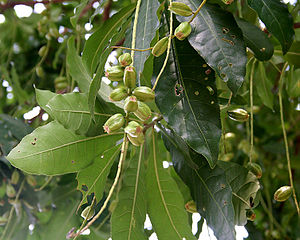Note: This is a project under development. The articles on this wiki are just being initiated and broadly incomplete. You can Help creating new pages.
Difference between revisions of "Barringtonia acutangula - Samudraphala"
(→References) |
(→References) |
||
| Line 80: | Line 80: | ||
<ref name="Leaf">[http://keralaplants.in/ BOTANIC DESCRIPTION]</ref> | <ref name="Leaf">[http://keralaplants.in/ BOTANIC DESCRIPTION]</ref> | ||
<ref name="Cultivation details">[https://www.tntreepedia.com/tree-details/?id=6d320b6d795808cf65dae019d1b41658 Cultivation details]</ref> | <ref name="Cultivation details">[https://www.tntreepedia.com/tree-details/?id=6d320b6d795808cf65dae019d1b41658 Cultivation details]</ref> | ||
| − | <ref name="Ayurvedic preparations">https://easyayurveda.com/2016/07/28/indian-oak-tree-barringtonia-acutangula/ Ayurvedic preparations]</ref> | + | <ref name="Ayurvedic preparations">[https://easyayurveda.com/2016/07/28/indian-oak-tree-barringtonia-acutangula/ Ayurvedic preparations]</ref> |
<ref name="Common names">[http://envis.frlht.org/bot_search Vernacular names]</ref> | <ref name="Common names">[http://envis.frlht.org/bot_search Vernacular names]</ref> | ||
</references> | </references> | ||
Revision as of 15:55, 3 June 2019
Samudraphala is an evergreen tree of moderate size, called by Sanskrit writers Hijja or Hijjala. The fruit is spoken of as Samudra-phala and Dhātriphala or "nurse’s fruit" and is one of the best known domestic remedies.
Contents
- 1 Uses
- 2 Parts Used
- 3 Chemical Composition
- 4 Common names
- 5 Properties
- 6 Habit
- 7 Identification
- 8 List of Ayurvedic medicine in which the herb is used
- 9 Where to get the saplings
- 10 Mode of Propagation
- 11 How to plant/cultivate
- 12 Commonly seen growing in areas
- 13 Photo Gallery
- 14 References
- 15 External Links
Uses
Fever, Diarrhea, Diarrhea, Bronchitis, Splenomegaly, Headache [1]
Parts Used
Chemical Composition
Common names
| Language | Common name |
|---|---|
| Kannada | dhatri phala, ganigalu |
| Hindi | hijjal, samandar-phal |
| Malayalam | arrupera, athambu, attampu, attapera, |
| Tamil | adampai, amamikkatampu, samuttirappalam, sengadambu |
| Telugu | Karpura-Bendakanapa chettu, kanigi, kanigi chettu, kurpa, neerkaniki |
| Marathi | NA |
| Gujarathi | NA |
| Punjabi | NA |
| Kashmiri | NA |
| Sanskrit | ambuja, samudraphala, dhatriphala, hijjala, |
| English |
Properties
Reference: Dravya - Substance, Rasa - Taste, Guna - Qualities, Veerya - Potency, Vipaka - Post-digesion effect, Karma - Pharmacological activity, Prabhava - Therepeutics.
Dravya
Rasa
Tikta (Bitter), Katu (Pungent)
Guna
Laghu (Light), Ruksha (Dry)
Veerya
Ushna (Hot)
Vipaka
Katu (Pungent)
Karma
Vata
Prabhava
Habit
Identification
Leaf
| Kind | Shape | Feature |
|---|---|---|
| Simple | Alternate | clustered towards the tip of branchlets; stipules lateral, cauducous; petiole 6-12 mm long, slender, glabrous; lamina 7-18 x 2.5-7 cm, oblanceolate, obovate or elliptic-obovate, base cuneate, or attenuate, apex obtuse, round or subacute, margin finely serrate, glabrous, subcoriaceous; lateral nerves 8-12 pairs, pinnate, slender, prominent, intercostae reticulate, slender, prominent. |
Flower
| Type | Size | Color and composition | Stamen | More information |
|---|---|---|---|---|
| bisexual | 6-8 mm long | Red | Many | terminal pendulous racemes; bracts small, deciduous; calyx tube campanulate, adnate to the ovary; lobes 4, ovate, acute, imbricate; petals 4, ovate, obtuse, imbricate, basally connate, adnate to the staminal tube; stamens many, in several rows; filaments exserted, filiform, 1.5 cm long, pink, connate below; ovary inferior, 2 mm, 2-celled, ovules 6-8 in each cell; style to 2 cm, filiform; stigma small. |
Fruit
| Type | Size | Mass | Appearance | Seeds | More information |
|---|---|---|---|---|---|
| Berry | 2.5-3.8 cm long | oblong-ovoid, bluntly quadrangular; seed one, ovoid. | {{{6}}} |
Other features
List of Ayurvedic medicine in which the herb is used
Where to get the saplings
Mode of Propagation
How to plant/cultivate
Seeds are soaked in boiled water and allowed to cool for 24 hours before sowing. [5]
Commonly seen growing in areas
Photo Gallery
References
External Links
- Ayurvedic Herbs known to be helpful to treat Fever
- Ayurvedic Herbs known to be helpful to treat Diarrhea
- Ayurvedic Herbs known to be helpful to treat Bronchitis
- Ayurvedic Herbs known to be helpful to treat Splenomegaly
- Ayurvedic Herbs known to be helpful to treat Headache
- Herbs with Leaves used in medicine
- Herbs with Roots used in medicine
- Herbs with Fruits used in medicine
- Herbs with Bark used in medicine
- Herbs with common name in Kannada
- Herbs with common name in Hindi
- Herbs with common name in Malayalam
- Herbs with common name in Tamil
- Herbs with common name in Telugu
- Herbs with common name in Sanskrit
- Habit - Tree
- Herbs that are commonly seen in the region of Tropical area
- Herbs that are commonly seen in the region of Coastal area
- Herbs
- Plants of western ghats
- Tree
- Ayurvedic herbs that don't have seed photos
- Lecythidaceae





